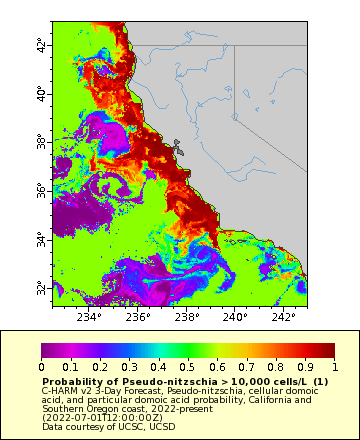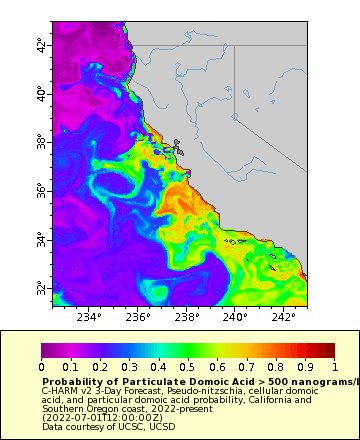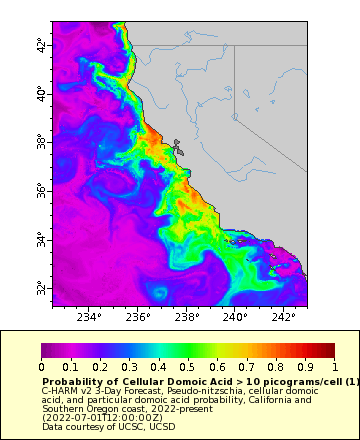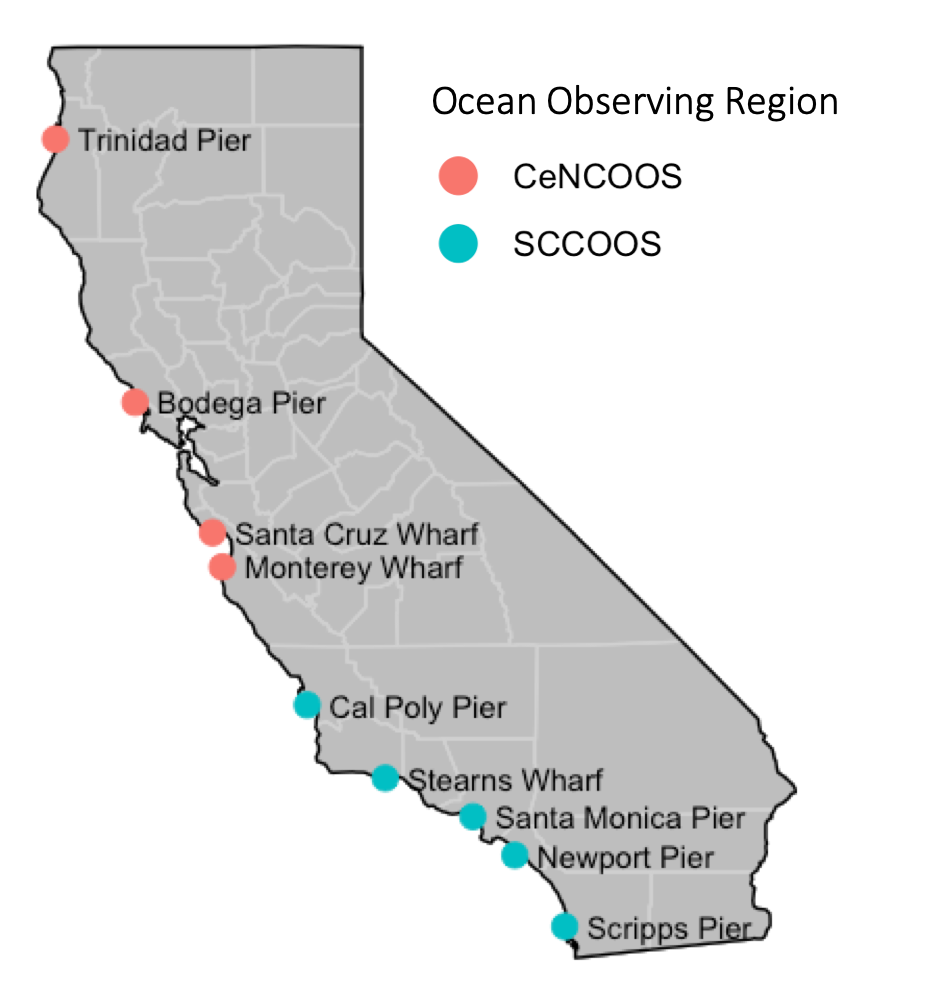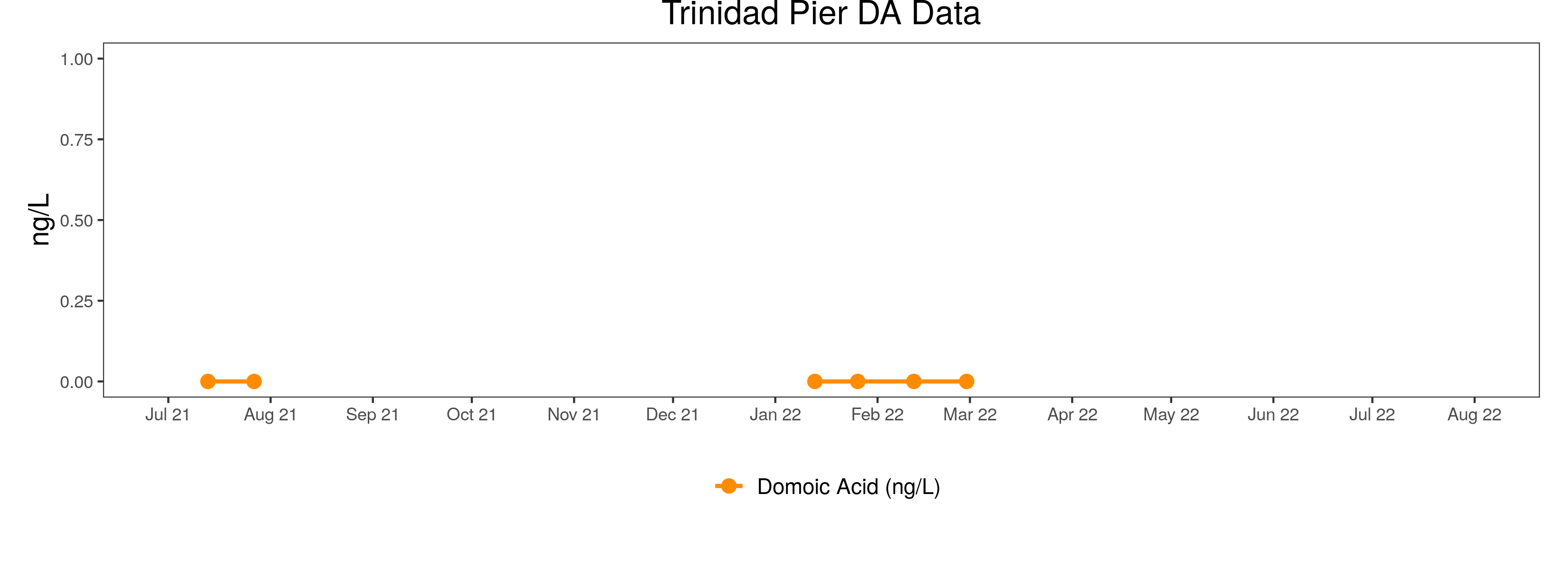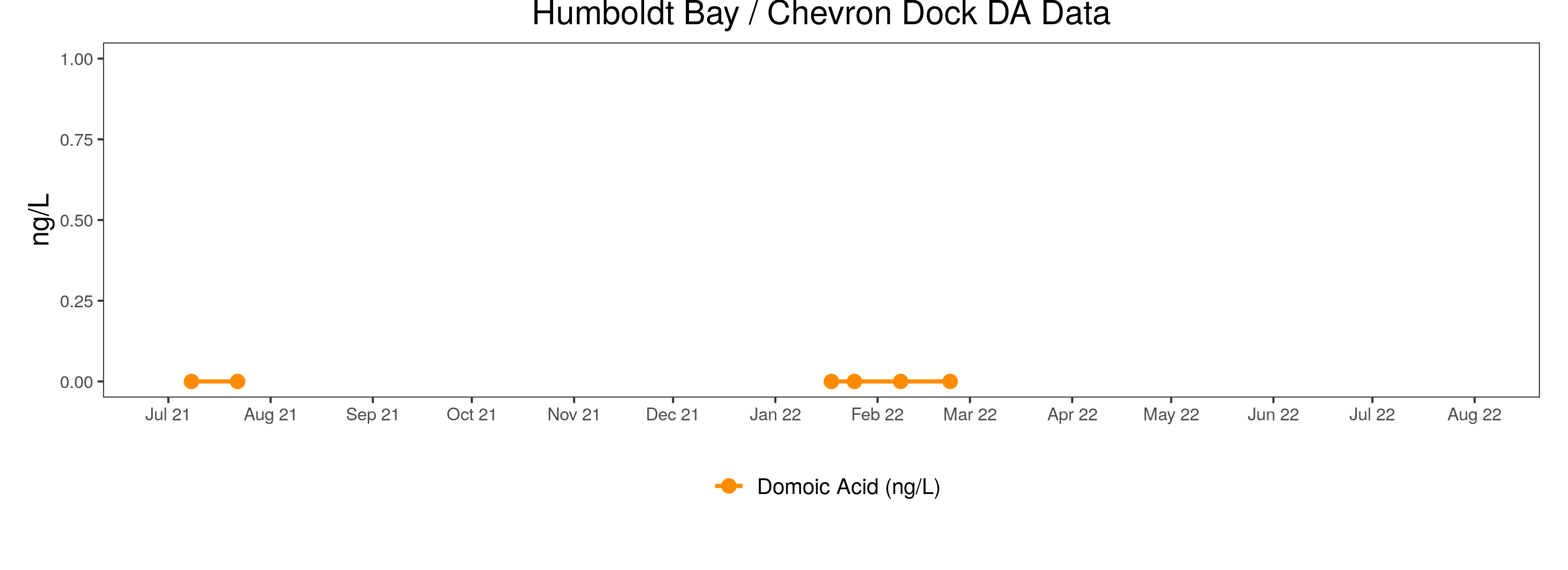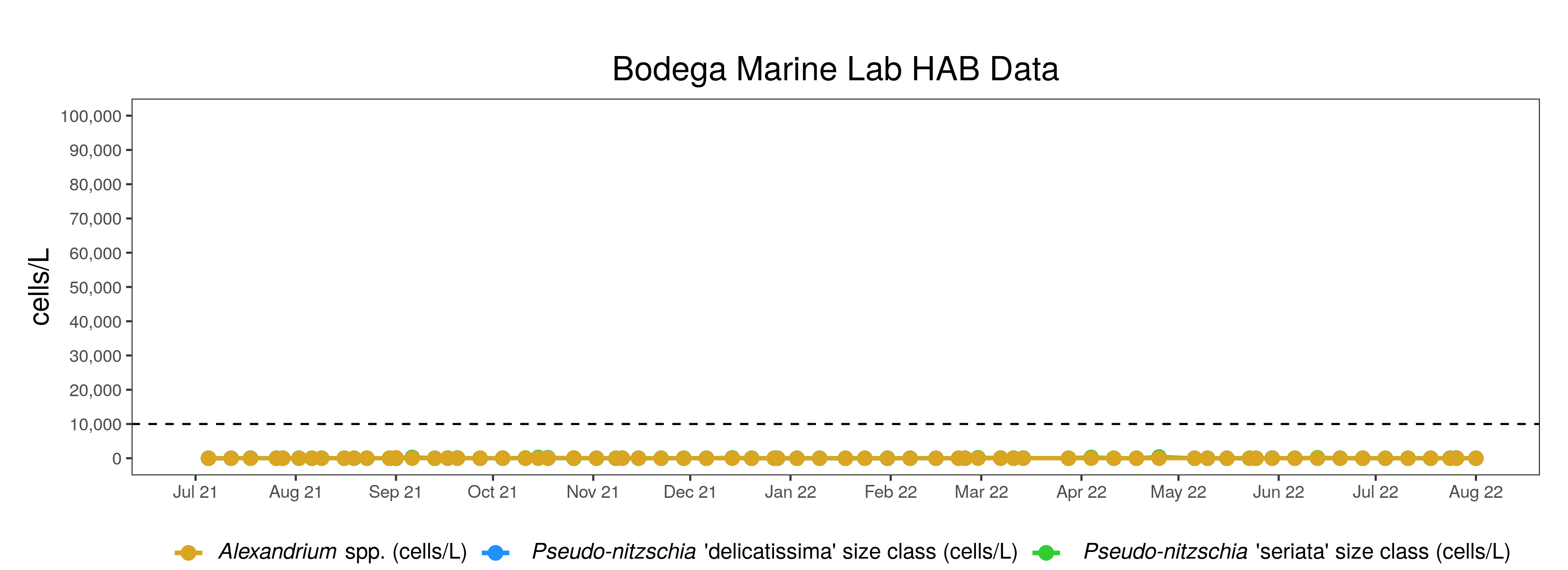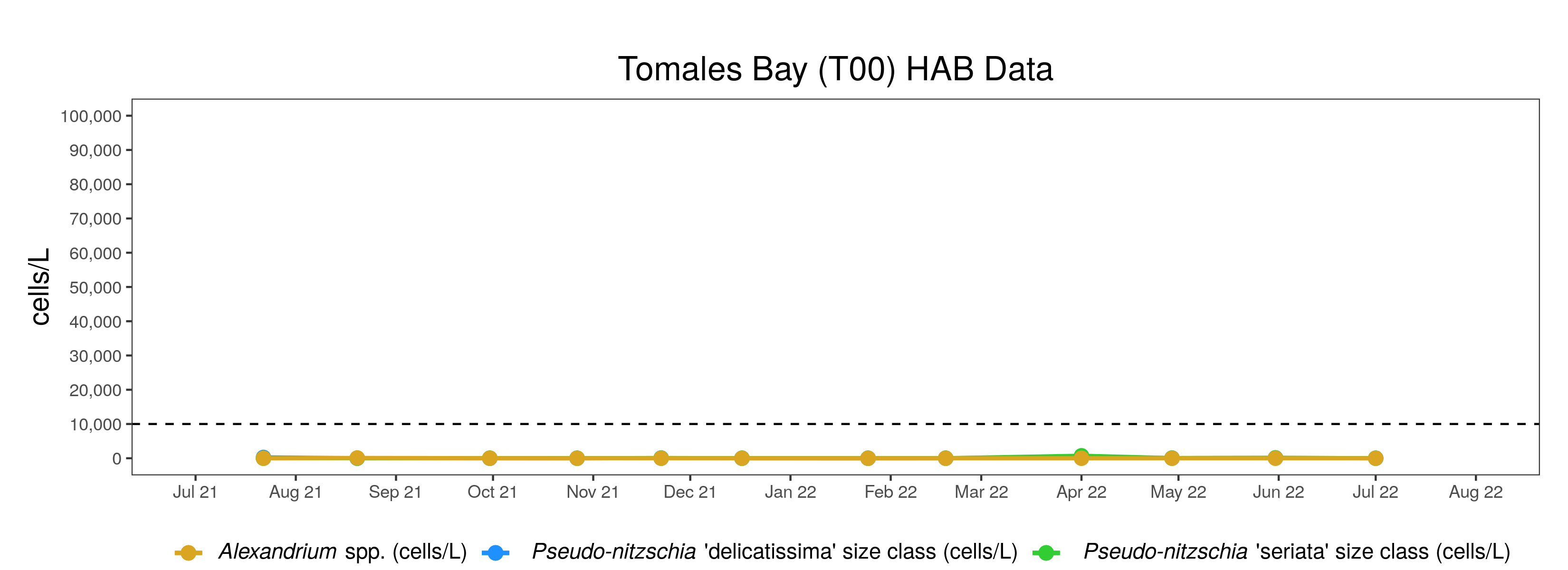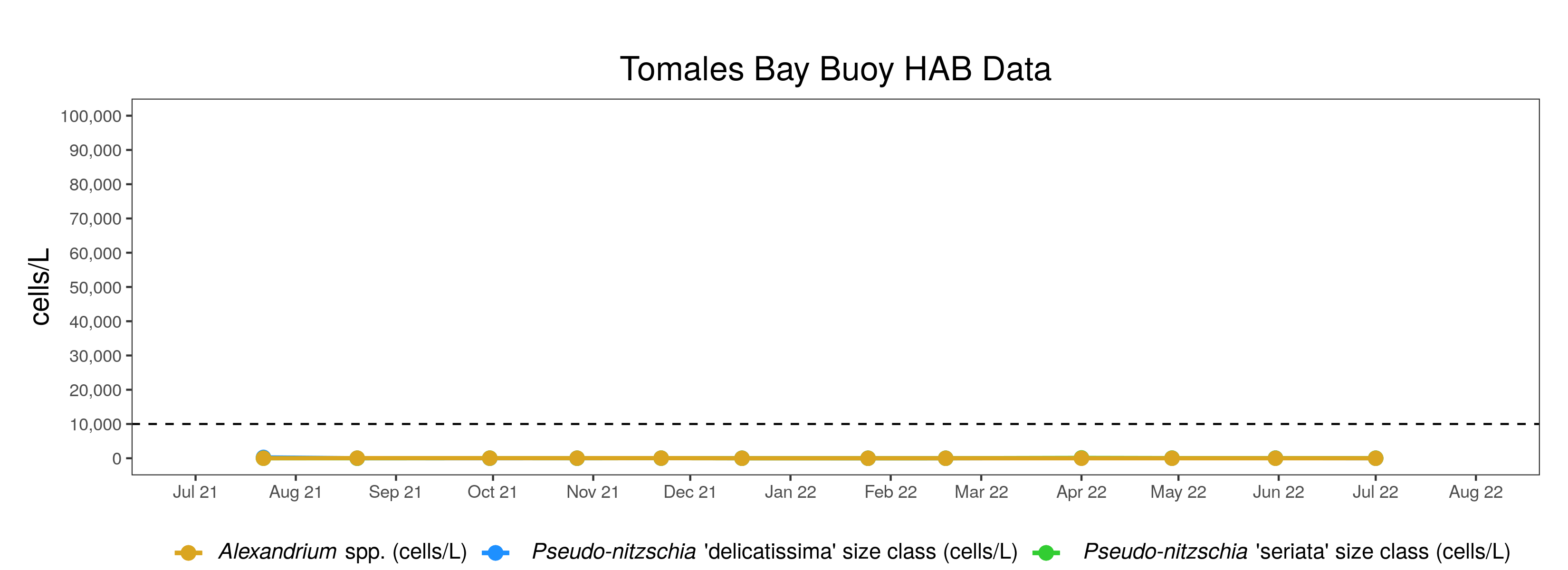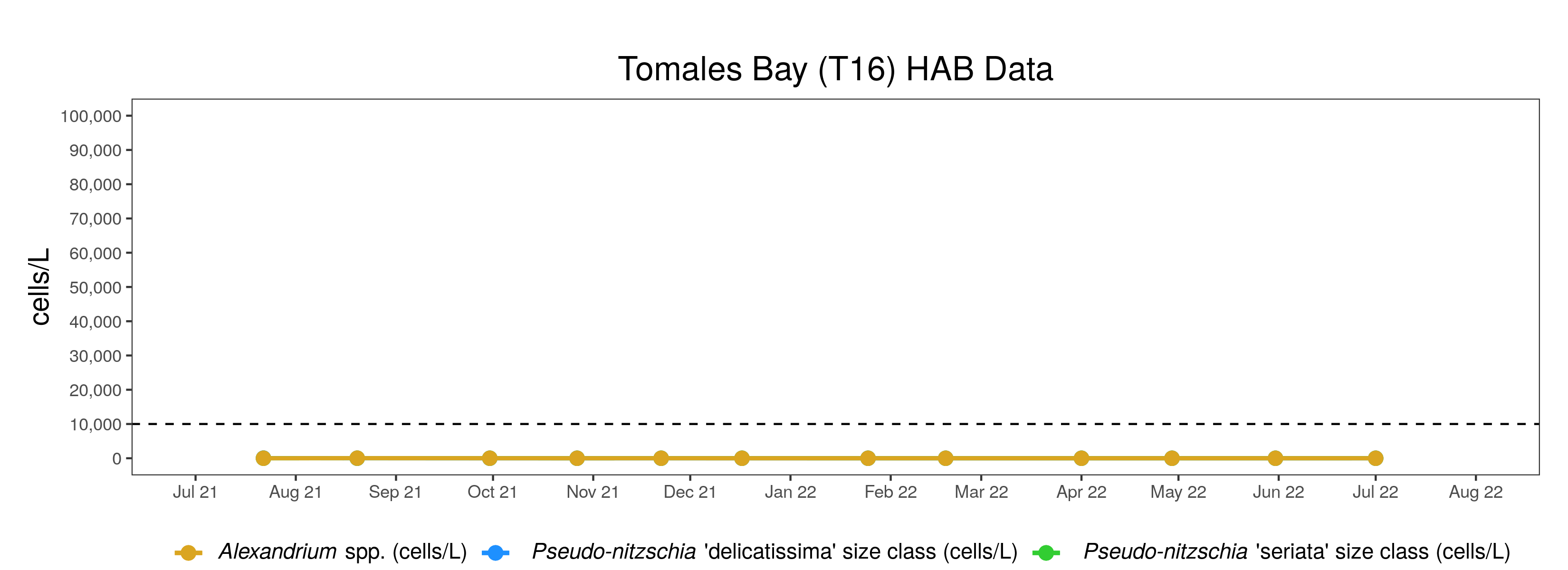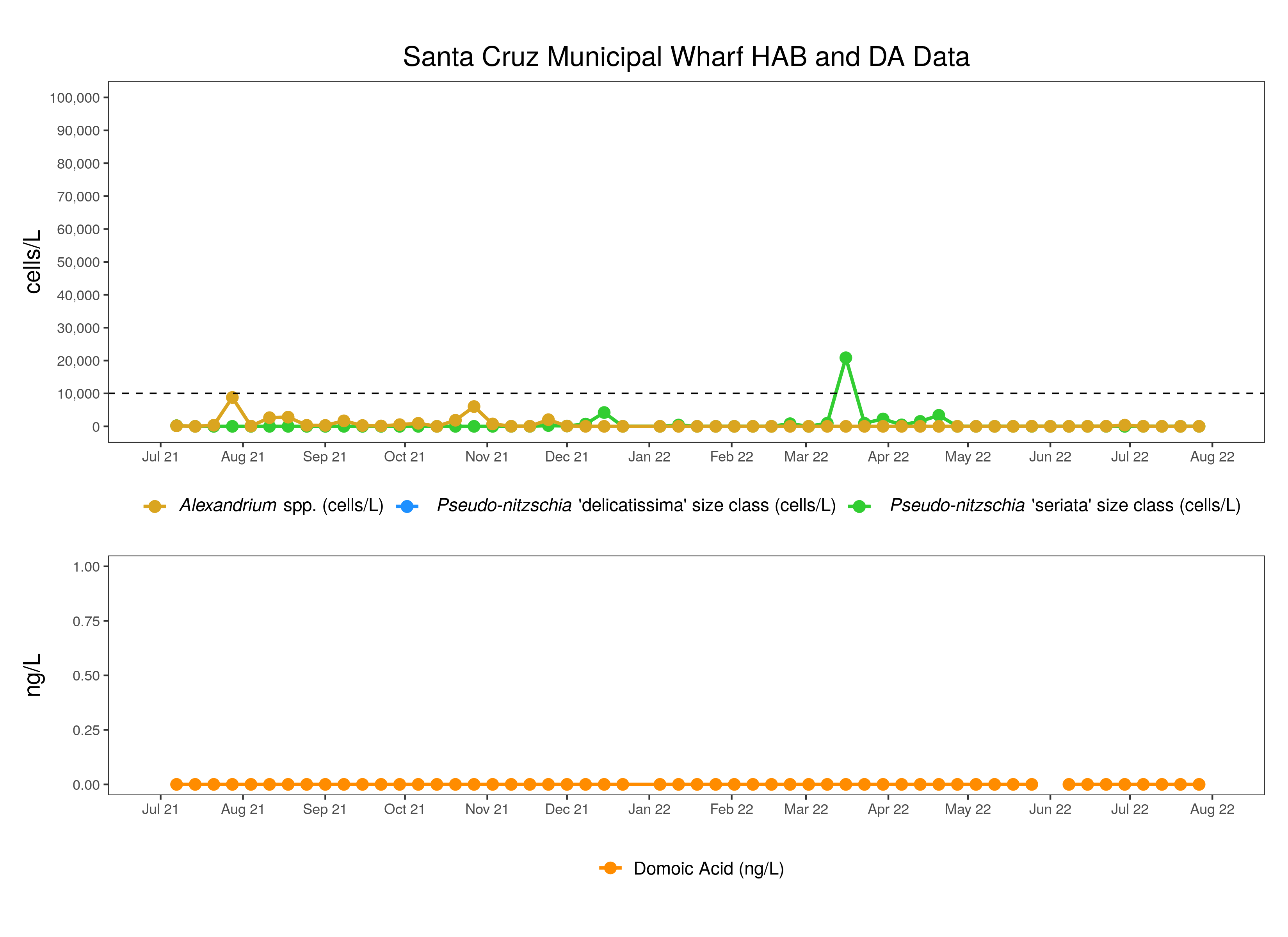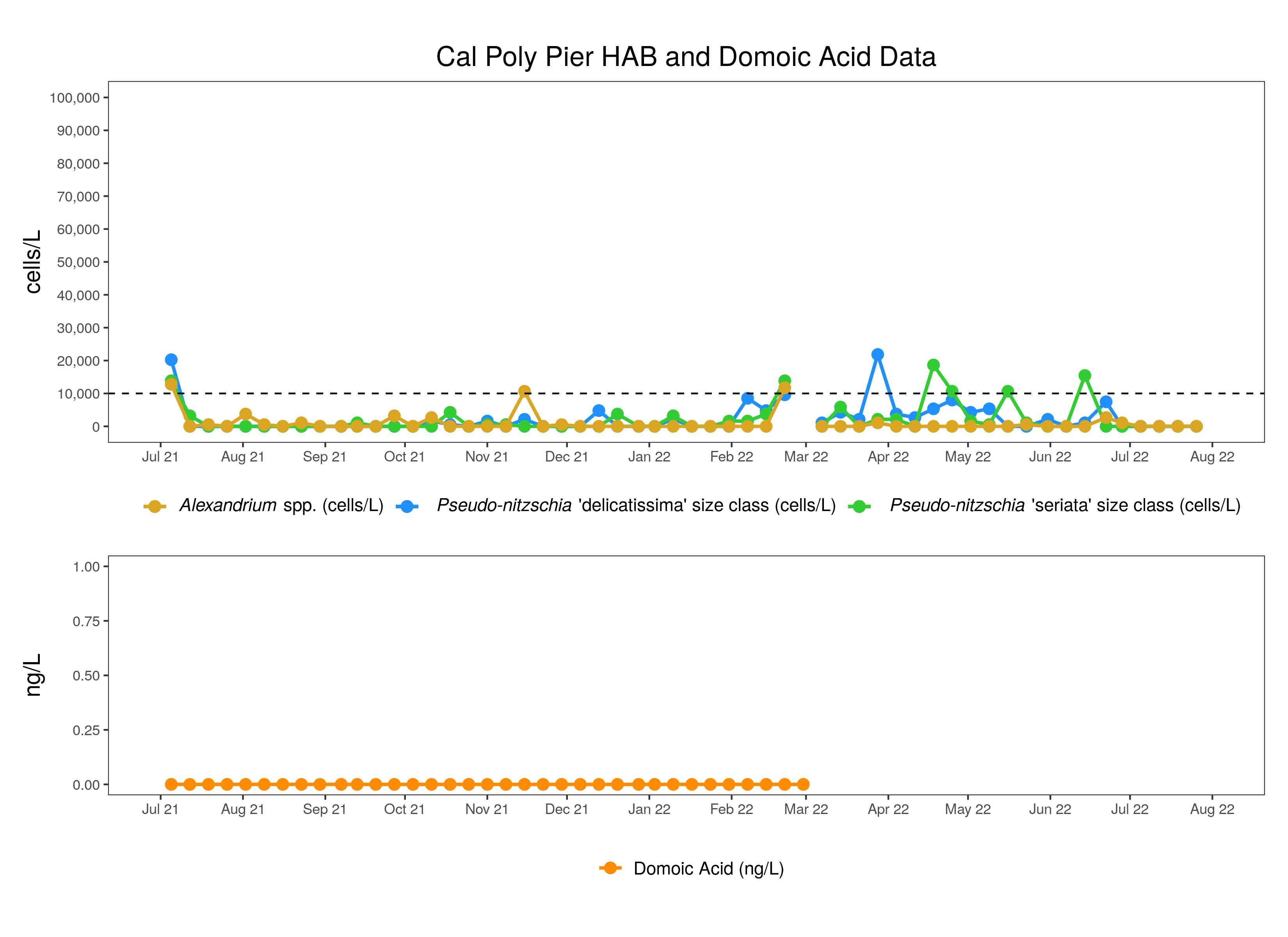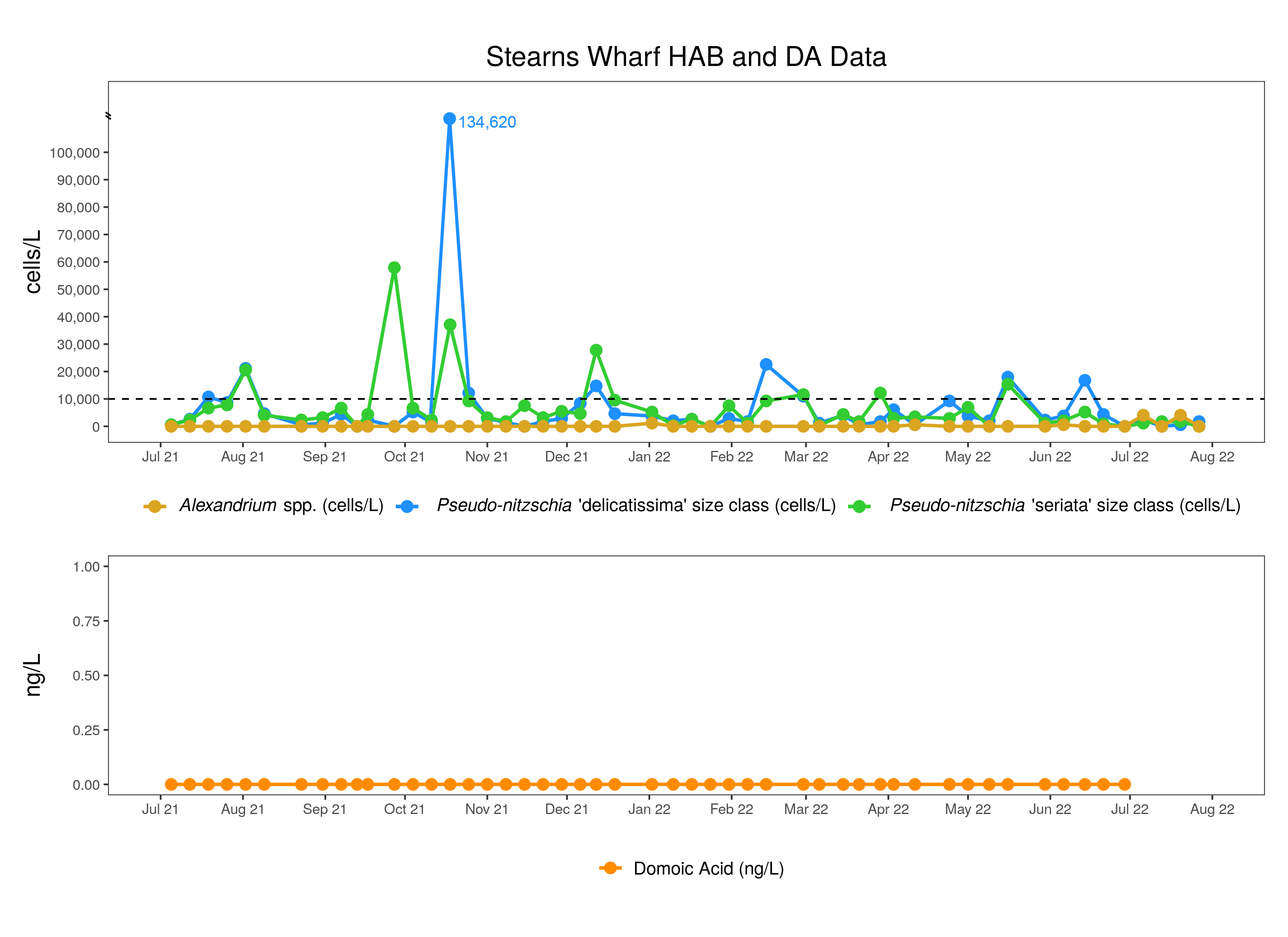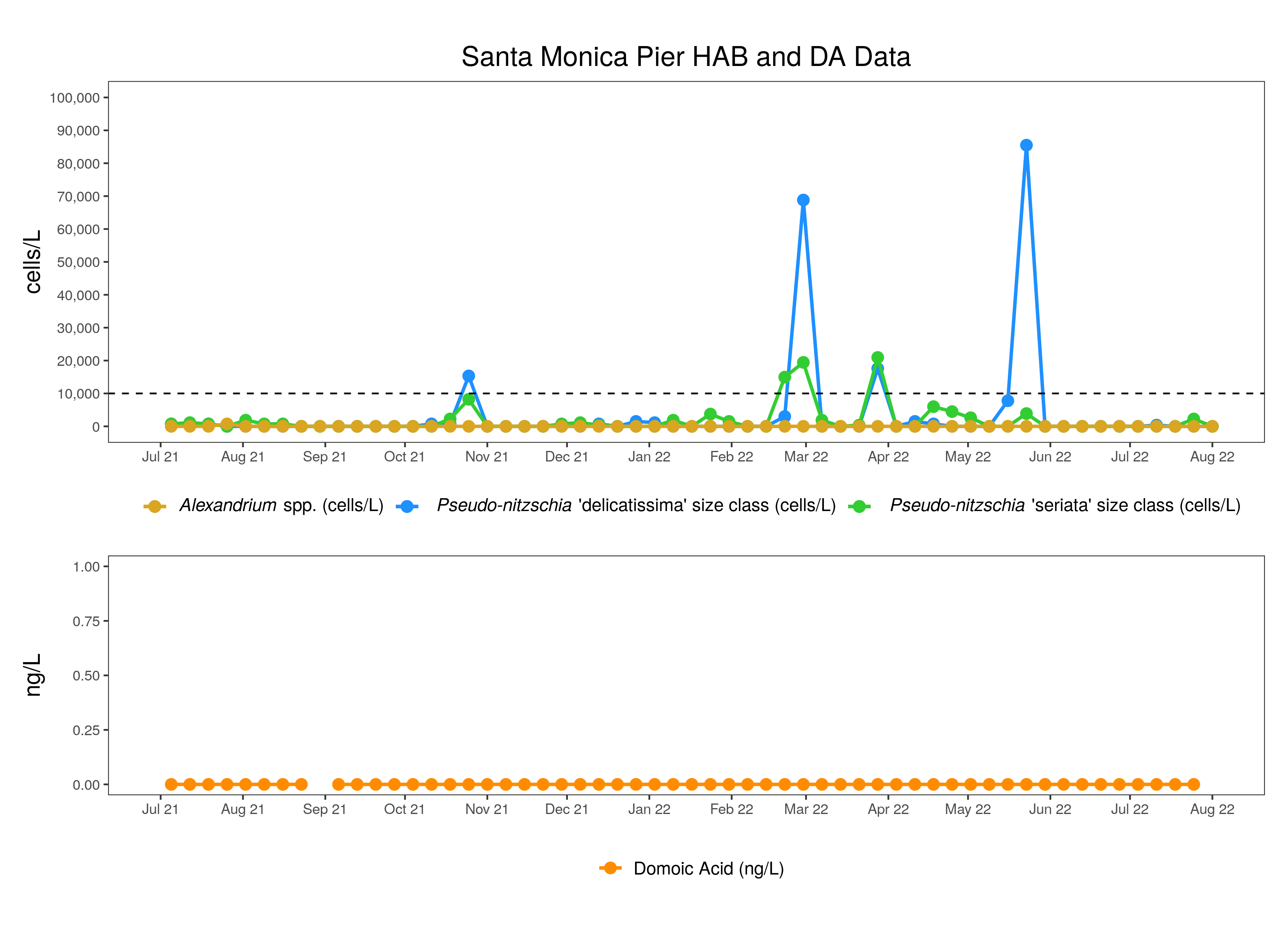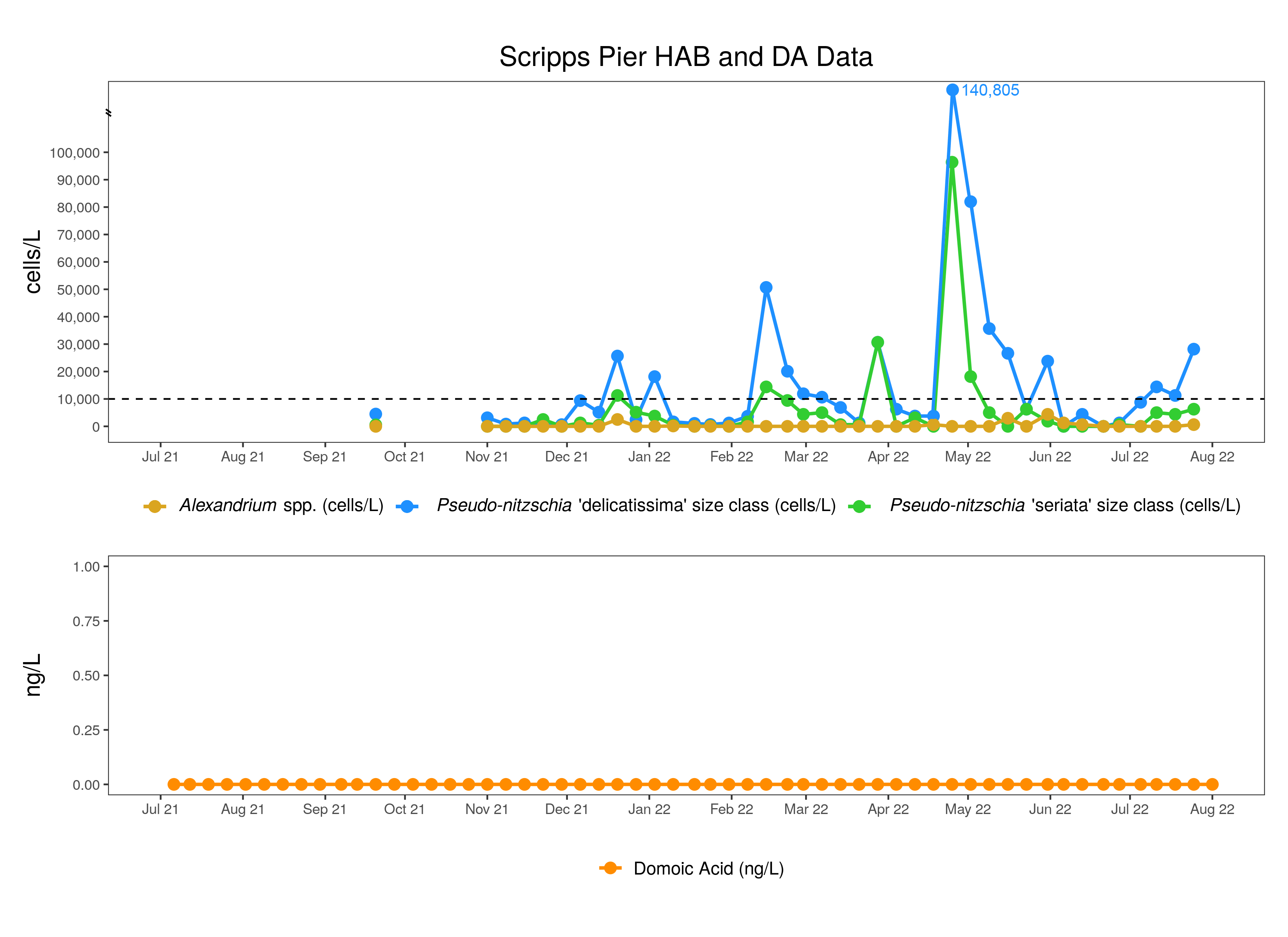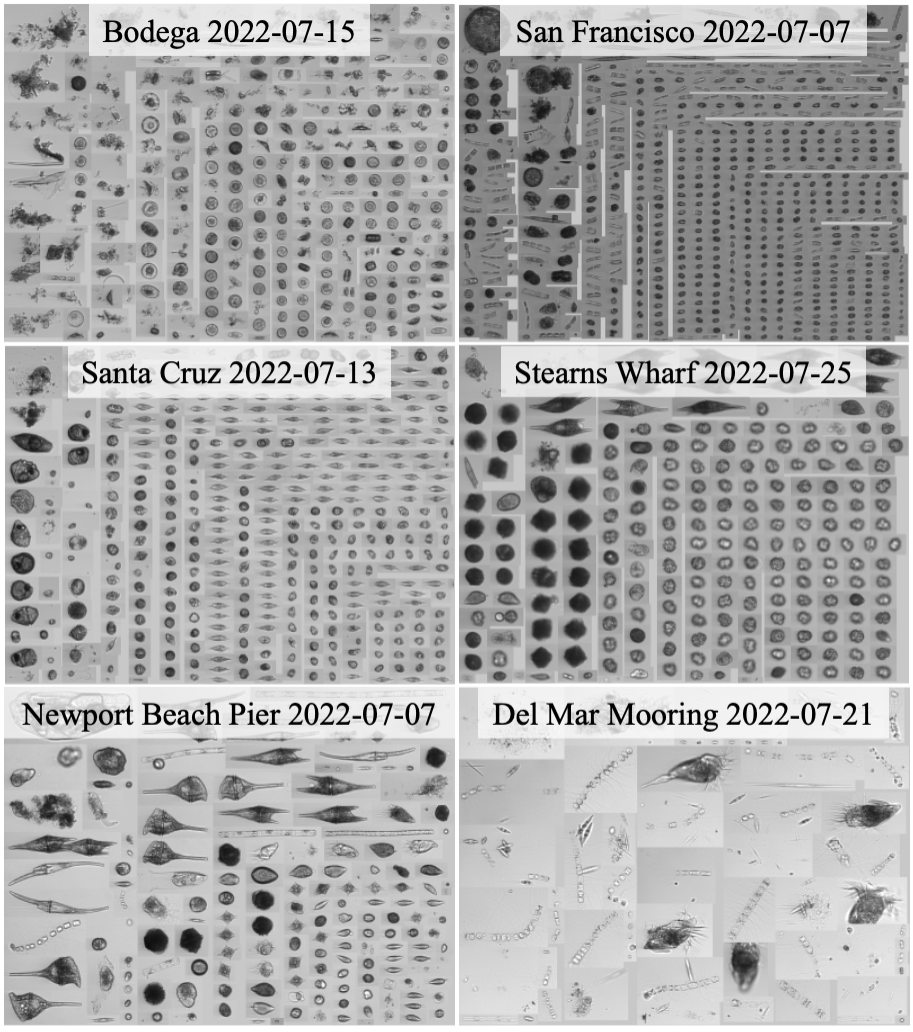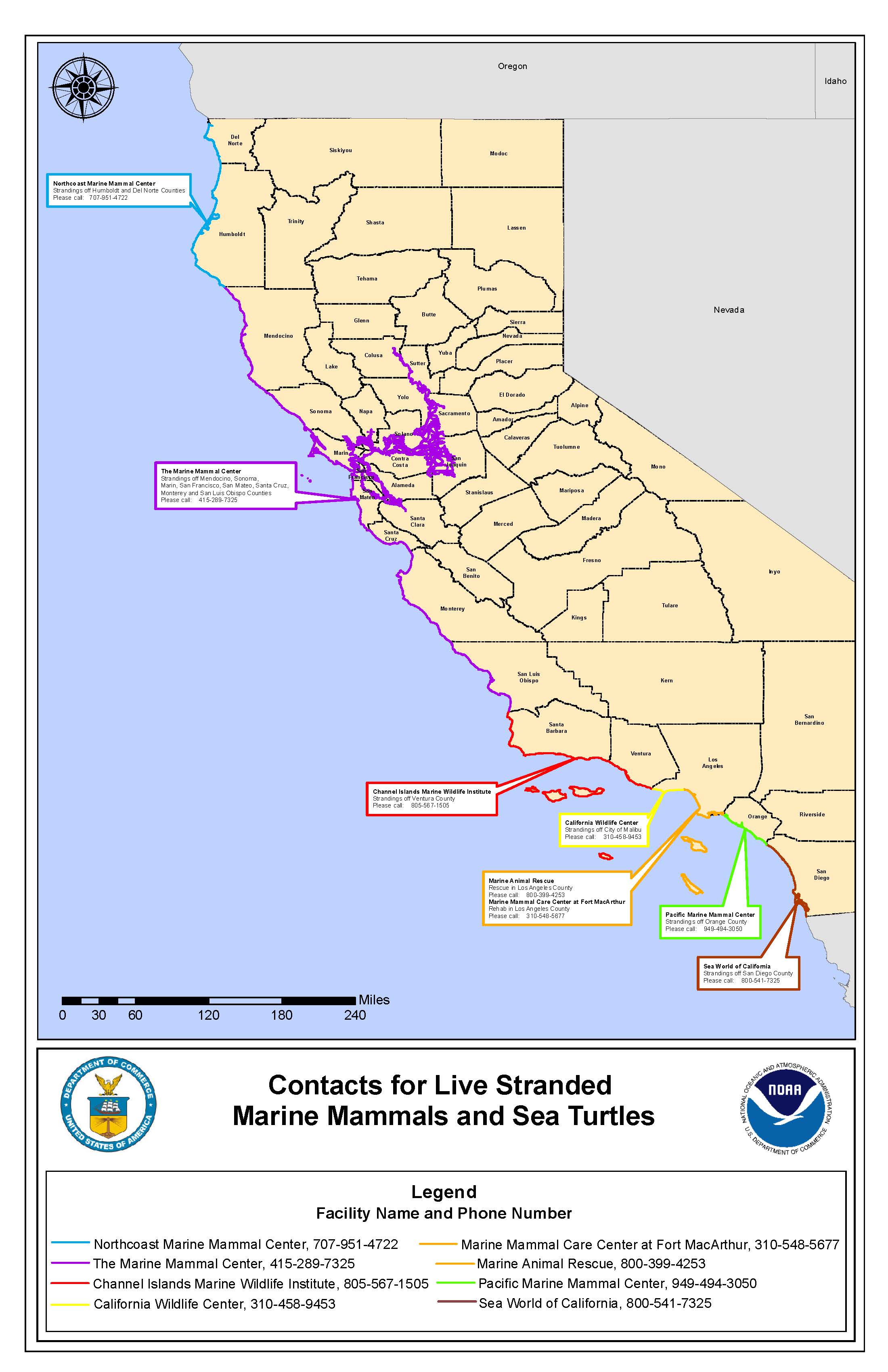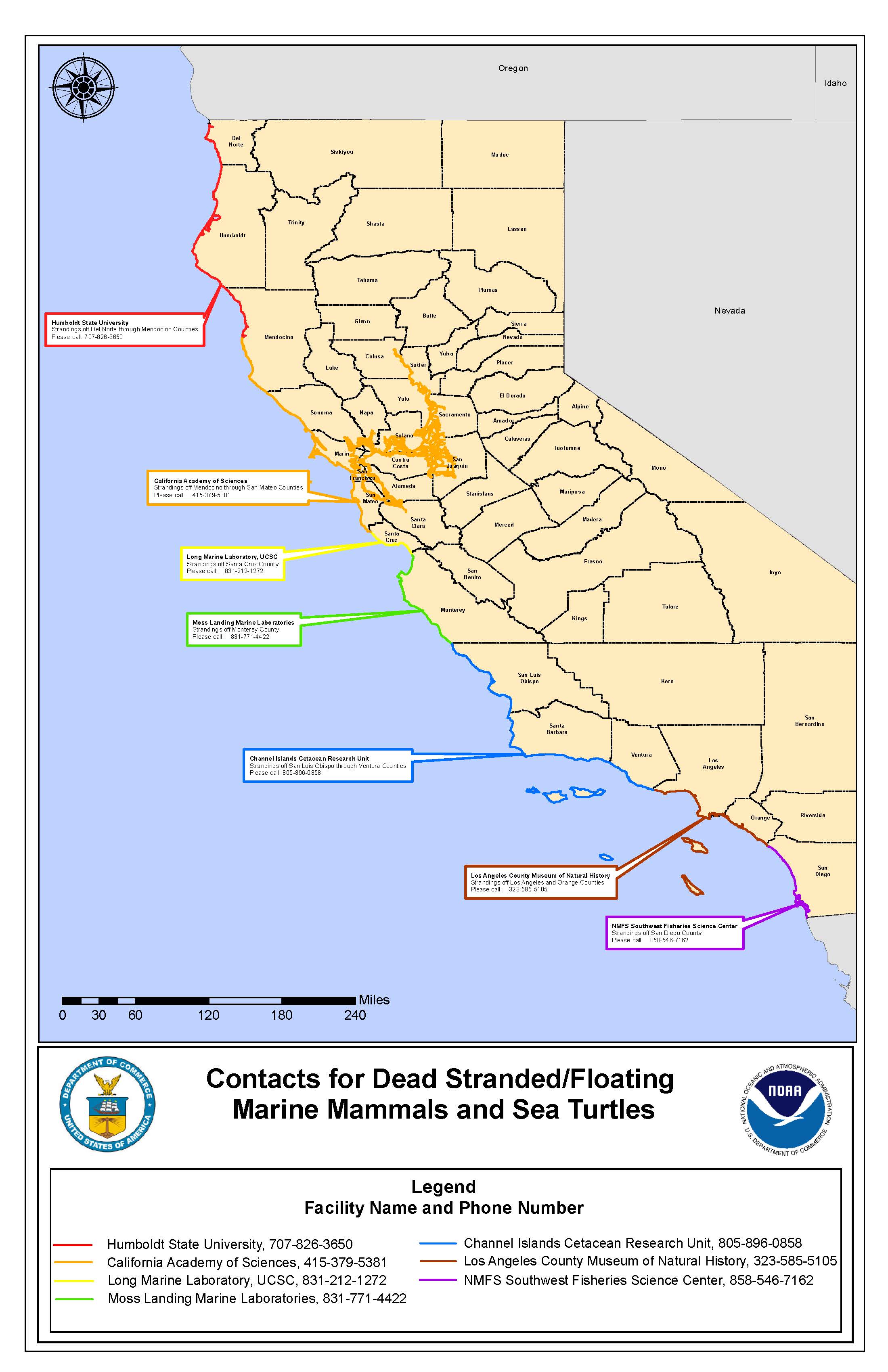JULY HIGHLIGHTS
*note: for the full suite of HAB taxa sampled weekly, see the SCCOOS and CeNCOOS HABMAP database and the Imaging FlowCytobot Dashboard.
Pseudo-nitzschia -
- C-HARM tells us where conditions are suitable for species of the diatom Pseudo-nitzschia spp. (all size classes) to grow well and where they might be more likely to produce the deadly neurotoxin, domoic acid (DA).
- C-HARM predictions for Pseudo-nitzschia spp. blooms in July were not that different from June in that the spatial variability of bloom risk was high throughout the month. An obvious emerging pattern was a fairly consistent, high risk in the Santa Barbara Channel as well as the central coast, which peaked mid-month and was at times very high in the northern California nearshore to offshore coastal zone. The most offshore region of the domain along the North Coast showed highly diminished risk, however. This was followed by a shift towards cells of high bloom probabilities fairly isolated to the North Coast and in the Santa Barbara Channel as well as sections of the South Coast.
- HABMAP pier sampling painted a different picture with fairly quiescent Pseudo-nitzschia spp. activity, only becoming detectable at Tomales Bay, Bodega Bay, Stearns Wharf, Santa Monica Pier. The less toxigenic 'delicatissima' size class did surpass the bloom "threshold" at the end of the month at Newport Beach Pier, in alignment with C-HARM projecting increased risk in Southern California at the end of July. The more toxigenic 'seriata' size class was detected at Tomales Bay, Bodega Bay, Newport, and Santa Monica, and actually reached bloom levels at Newport Beach Pier on Aug 1st; stay tuned for the August Bulletin and a major DA event underway.
- Pseudo-nitzschia activity from CDPH coastal sampling, however, detected Pseudo-nitzschia 'seriata' as 'Common' at a handful of sites from Santa Monica to the Gulf of Farallones National Marine Sanctuary in July. The 'seriata' size class was detected as 'Present' at sites throughout California, consistent with the statewide bloom risk that moved up and down the coast according to C-HARM predictions.
- The CA Imaging FlowCytobot Network images (not all shown) illustrate the incredible south to north variability in phytoplankton communities. Mixed assemblages of chain-forming diatoms and dinoflagellates dominated southern sites, with moderate levels of Lingulodinium, Prorocentrum, and other potential "red tide" forming dinoflagellates. The offshore Del Mar mooring in San Diego picked up quite a few diatoms, including chains of Pseudo-nitzschia, relative to nearshore IFCBs. Central to northern sites were somewhat similar but with many more pennate and solitary centric diatoms in high abundance.
- C-HARM probabilities for particulate domoic acid (pDA) in July were similar to those in June in that the northern/central coast from Sonoma County to the Santa Barbara Channel region was a hot spot of potential DA activity for much of the month. Throughout much of July, a narrow band along the South Coast was also predicted to have high pDA, however, there were not many Pseudo-nitzschia detected at those sites from HABMAP, which was inconsistent with CDPH sampling.
- The pattern for C-HARM predictions of cellular domoic acid (cDA) probability were similar to pDA for July in that the Central Coast was a hot spot, but diverged in other ways. For instance, there were very low cDA probabilities from the Santa Barbara Channel and into the Southern California Bight. In central California, the areas of intensity were predicted to be north of San Francisco Bay near Marin and Sonoma Counties, the coast between San Luis Obispo and Monterey Bay, and parts of the North Coast towards the end of the month.
- Unfortunately, the results for DA from HABMAP sampling is still limited for July for some sites.
- There was only one potential DA toxicosis case reported in July, and that female California Sea Lion stranded in Santa Cruz mid-month, consistent with the intense DA predictions for the Monterey Bay/ central California region from C-HARM.
- Note that CDPH lifted the razor clam domoic acid health advisory on June 27th, but the annual quarantine on consuming recreational mussels is still in effect until October.
Alexandrium -
- CDPH detected "Present" relative abundances of Alexandrium spp. at Scripps Pier and Shelter Island in San Diego and "Rare" at many southern and central Californian sites, consistent with HABMAP sampling at Stearns Wharf and Santa Cruz Wharf that also detected Alexandrium spp. at low levels. There are currently no advisories for Paralytic Shellfish Poisoning.
Summary written by Clarissa Anderson on Aug 31, 2022
Note that data for some stations are not shown because they are not yet recorded in the public HABMAP archive.
Differentiating Pseudo-nitzschia species by light microscopy is difficult. For this reason, Pseudo-nitzschia "seriata" does not refer to an actual species but rather the larger size class of Pseudo-nitzschia, which is generally a more toxigenic group of species. Alternatively, Pseudo-nitzschia "delicatissima" refers to the smaller size class that is generally non-toxigenic. The dashed line on the plots demarcates the 10,000 cells/L "bloom" threshold designated here for Pseudo-nitzschia populations only.
More information and data visualizations on the statewide HAB network and forecasting system can be found on the California HABMAP website and on the SCCOOS Harmful Algal Bloom page.
Five water samples were collected at Bodega Marine Lab in July. Pseudo-nitzschia "delicatissima" was detected on 3 occasions (July 11, 24, 26) below the bloom threshold. Pseudo-nitzschia "seriata" was detected twice (July 11, 26) below the bloom threshold. Alexandrium spp. were not detected. Domoic acid results are pending.
The Bodega Marine Lab shore station is supported by CeNCOOS PI John Largier.
Four water samples were collected at Santa Cruz Wharf in July. Molecular probes for toxigenic Pseudo-nitzschia in the "seriata" class are conducted for this site, and was not detected. Alexandrium spp. were detected twice (July 6, 27). Domoic acid was not detected.
The Santa Cruz Wharf shore station is supported by CeNCOOS PI Raphael Kudela at UCSC
Four water samples were collected at Stearns Wharf in July. Pseudo-nitzschia "delicatissima" was detected on three occasions (July 6, 20, 27) below the bloom threshold. Pseudo-nitzschia "seriata" was also detected on three occasions (July 6, 13, 20) below the bloom threshold. Alexandrium spp. were detected twice (July 6, 20). Domoic acid results are pending.
Stearns Wharf is supported by SCCOOS and PIs Mark Brzezinski and Libe Washburn at UCSB.
Four water samples were collected at Santa Monica Pier in July. Pseudo-nitzschia "delicatissima" was detected once on July 11, below the threshold. Pseudo-nitzschia "seriata" was also detected once on July 25, below the threshold. Alexandrium spp. and domoic acid were also not detected.
The Santa Monica Pier shore station is supported by SCCOOS and PI Rebecca Shipe at UCLA.
Four water samples were collected at Newport Beach Pier in July. Pseudo-nitzschia "delicatissima" was detected three times (July 11, 18, 25) with the last two samples above the threshold. Pseudo-nitzschia "seriata" was detected once (July 18) below the threshold, but then exceeds the threshold on August 1. Alexandrium spp. and domoic acid were not detected.
Newport Beach Pier is supported by SCCOOS and PI David Caron at USC.
Four water samples were collected at Scripps Pier in July. Pseudo-nitzschia "delicatissima" was detected on each occasion (July 5, 11, 18, 25) with the last three above the bloom threshold. Pseudo-nitzschia "seriata" was detected three times (July 11, 18, 25), all below the threshold. Alexandrium spp. were detected once on July 25. Domoic acid was not detected.
Scripps Pier is supported by SCCOOS and PIs Melissa Carter and Clarissa Anderson at UCSD.
CDPH observations for Pseudo-nitzschia "seriata" and Alexandrium spp.
View the interactive map and data table of California Department of Public Health (CDPH) data from January 2019 to present, developed by SCCOOS, below. Or, view CDPH Toxic Phytoplankton Observations Map with layers of Pseudo-nitzschia and Alexandrium spp. as well as other phytoplankton species observations (in the pop-up windows).
Data are provided by the Environmental Management Branch of the CDPH. Please note, starting in July 2019, CDPH moved to only reporting Pseudo-nitzschia of the seriata complex and not all Pseudo-nitzschia spp. as previously provided.
Please email CDPH at Susan.Paulukonis@cdph.ca.gov for any potential marine HAB-related illness in humans.
From July 1-31 2022, water samples were collected by volunteers and sent to the California Department of Public Health (CDPH) for analysis.
Pseudo-nitzchia "seriata" group was detected in 44 of the 105 samples:
Pseudo-nitzschia "seriata" was detected at "Common" density levels on 5 occasions:
- 2022-07-08 42% Port San Luis, Diablo Cove
- 2022-07-14 11% Wilson Creek
- 2022-07-21 15% Santa Monica Pier
- 2022-07-29 10% GFNMS, Marin Line 11E
- 2022-07-29 30% San Simeon Pier
Pseudo-nitzschia "seriata" was detected at "Present" density levels on 19 occasions:
- 2022-07-01 2% San Simeon Pier
- 2022-07-01 3% Pacifica Pier
- 2022-07-04 1% Tomales Bay, Lease #M430-15
- 2022-07-04 4% Trinidad Pier
- 2022-07-11 1% La Jolla, Scripps Pier
- 2022-07-11 3% Humboldt Bay, Indian Is. Ch.
- 2022-07-15 1% Santa Cruz Is., Scorpion Anch.
- 2022-07-15 3% Hunter Rock, north
- 2022-07-18 3% Mendocino, Noyo Harbor
- 2022-07-20 3% Goleta Pier
- 2022-07-20 4% Monterey Bay, Commercial Wharf
- 2022-07-21 3% Port San Luis, Diablo Cove
- 2022-07-22 4% Bolsa Chica
- 2022-07-25 1% La Jolla, Scripps Pier
- 2022-07-26 3% Mendocino, Noyo Harbor
- 2022-07-28 5% GFNMS, Marin Line 2W
- 2022-07-28 5% GFNMS, Marin Line N2WN
- 2022-07-28 9% Port San Luis, Diablo Cove
- 2022-07-29 5% Marin, OFFSHORE
Pseudo-nitzschia "seriata" was detected at "Rare" density levels on 20 occasions:
- 2022-07-01 0.5% Bolsa Chica
- 2022-07-05 0.5% Mendocino, Noyo Harbor
- 2022-07-05 0.5% Ventura, Port Hueneme Pier
- 2022-07-05 0.5% Santa Monica Pier
- 2022-07-08 0.5% San Simeon Pier
- 2022-07-12 0.5% Bodega Bay
- 2022-07-13 0.5% Goleta Pier
- 2022-07-14 0.5% San Clemente Pier
- 2022-07-15 0.5% Bolsa Chica
- 2022-07-16 0.2% San Simeon Pier
- 2022-07-18 0.5% Tomales Bay, Lease #M430-15
- 2022-07-18 0.5% Morro Bay, Boat Launch
- 2022-07-18 0.5% Humboldt Bay, Indian Is. Ch.
- 2022-07-18 0.5% La Jolla, Scripps Pier
- 2022-07-18 0.5% Paradise Cove
- 2022-07-21 0.5% Palos Verdes Rocky Pt Offshore
- 2022-07-22 0.5% GFNMS, Marin Line N4-WN
- 2022-07-24 0.5% Pacifica Pier
- 2022-07-25 0.5% Humboldt Bay, Indian Is. Ch.
- 2022-07-28 0.5% Bodega Harbor, USCG Dock
Alexandrium spp. were detected in 9 of the 105 samples:
Alexandrium spp. were not detected at "Common" density levels.
Alexandrium spp. were detected at "Present" density levels on 2 occasions:
- 2022-07-05 1% La Jolla, Scripps Pier
- 2022-07-07 2% San Diego Bay, Shelter Island
Alexandrium spp. were detected at "Rare" density levels on 7 occasions:
- 2022-07-01 0.5% San Simeon Pier
- 2022-07-08 0.5% Cayucos Pier
- 2022-07-11 0.5% La Jolla, Scripps Pier
- 2022-07-13 0.5% Imperial Beach Pier
- 2022-07-15 0.5% Pacifica Pier
- 2022-07-15 0.5% San Diego Bay, U.S. Navy Pier
- 2022-07-17 0.5% San Diego Bay, Shelter Island
CDPH and OEHHA Health Advisories
June 27. The California Department of Public Health (CDPH) has lifted the shellfish safety notification related to sport-harvested razor clams in Del Norte County.
April 26. The California Department of Public Health (CDPH) today announced the annual quarantine of sport-harvested mussels gathered along the California coast beginning May 1.
April 2. The California Department of Public Health (CDPH) warned consumers today not to eat raw oysters from British Columbia, Canada because they may be linked to an outbreak of norovirus illnesses in California. Canadian officials continue to investigate the source of norovirus illnesses and have closed multiple growing regions in British Columbia for sanitary contamination.
December 16. The California Department of Public Health (CDPH) is advising consumers not to eat sport-harvested razor clams from Del Norte County due to dangerous levels of naturally occurring domoic acid, also referred to as Amnesic Shellfish Poisoning, being detected.
November 29. The California Department of Public Health (CDPH) has lifted the shellfish safety notification for Dungeness crab caught in state waters from the Sonoma/Mendocino County Line (38° 46.125' N. Latitude) to Point Reyes (38° N. Latitude) in Marin County.
November 5. Due to the detection of elevated levels of domoic acid, a naturally occurring toxin, the California Department of Public Health (CDPH) is warning consumers not to eat the viscera (internal organs) of Dungeness crab caught in coastal waters.
For the latest closures and updates, please visit the CDPH Health Advisories page as a central location of information related to CDPH health advisories. Also available is a map showing the current CDPH Recreational Bivalve Shellfish Advisories (see below).
The HAB-related illness workgroup has developed a new webpage for marine HAB-related illness tracking work (https://oehha.ca.gov/fish/general-info/marine-harmful-algal-bloom-hab-related-illness-tracking).
A network of Imaging FlowCytobots (IFCBs) continuously photographs particles, such as plankton, in the water. Using machine learning, plankton species can be automatically identified. This will help improve the ability to detect and respond to Harmful Algal Blooms, including the ability to assess conditions that may lead to toxin production or blooms of toxin-producing algae.
Additional images and data are available on the IFCB dashboard.
A sampling of IFCB images from July, capturing a range of species.
Domoic acid (DA) is a potent neurotoxin produced by some diatom species of the genus Pseudo-nitzschia. Species exposed to DA can result in seizures, epilepsy, cardiomyopathy, and death depending upon the ingested dose. DA toxicosis commonly occurs in California Sea Lions (Zalophus californianus), presumably due to a combination of foraging behavior and seasonal movements. The Marine Mammal Center (TMMC), Channel Islands Marine Wildlife Institute (CIMWI), California Wildlife Center (CWC), Marine Mammal Care Center Los Angeles (MMCC-LA), Marine Animal Rescue (MAR), the Pacific Marine Mammal Center (PMMC), SeaWorld, and Southwest Fisheries Science Center (SWFSC) act like an emergency room by working to rescue and rehabilitate sick and injured marine mammals, seabirds, and sea turtles.
PMMC, MMCCLA, SeaWorld, CIMWI and CWC did not record any strandings due to suspected domoic acid in July 2022. Results from SWFSC and MAR are pending.
July strandings due to suspected DA toxicosis occurred in the following counties:
- Santa Cruz (TMMC)
- July 13 - Adult, female, California Sea Lion

